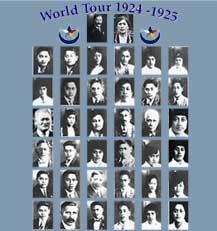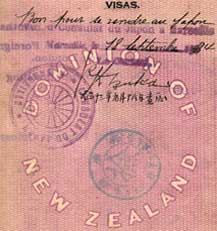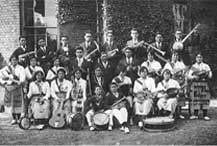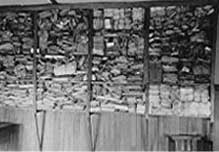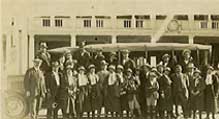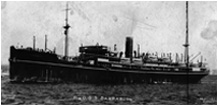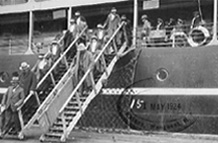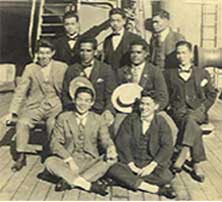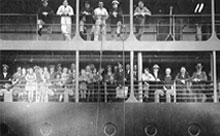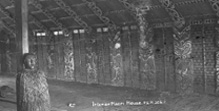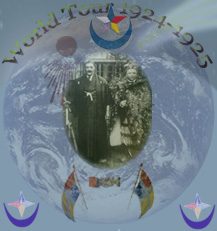

Home | E
|Nga Apiha whakahaere o te tiima o Te Mangai | World Tour Party | 22nd May 1924
| Ratana in England
1924 | T.W.Ratana
and Bishop Nakata | 1925
American Tour
(WORLD TOUR 1924-1925)
Tahupotiki Wiremu Ratana had announced he would take the most strenuous and ambitious of all tours consisting of a group of 24 young musicians. He establishment the first Band in the Ratana Movement “Te Peene A Te Mangai” 24 piece band a group of specially selected young people; 12 young woman and 12 young men that would perform haka, and poi dancers that will take British Empire Exhibition by storm. He was accompanied by a group of Kaumatua and Kuia to the British Empire Exhibition. The first world tour would commence from the 9th April to 12th December 1924 and the second leg of the world tour 17th August to the 21st December 1925. T.W.Ratana will also take the grievances of the Treaty of Waitangi to Geneva with no support from the New Zealand Government.
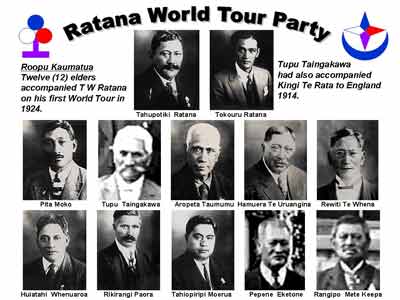
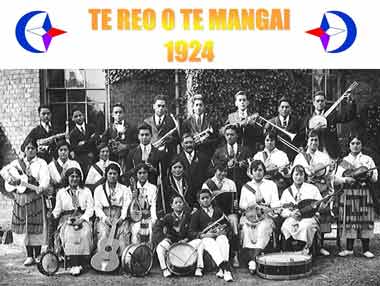
T.W.Ratana understood democracy, how democracy would work for his people. Ratana took out petitions and referendums and Kawenata, which gave him a mandate enabling him, too protect the rights for Iwi, Hapu and Whanau. One of Ratana’s strengths is he always consulted with his people and asked if they supported his Kaupapa or policy to sign it. This would empower him with the mandate to implement the thoughts and hopes for his Maori people within the legal systems of the New Zealand Government. In his 1924, world tour he travelled to the British Empire, England and Geneva taking his petition and grievances for the Treaty of Waitangi, following the footsteps of Kingi Tawhao in 1884, and Kingi Rata in 1914. The great Maori leaders before Ratana had already taken the Tiriti O Waitangi overseas testing Maori grievances with International law. There was no support given from the New Zealand Government to help Ratana and his Tiriti petition to be recognised and written into statue law. (Ratana T, World Tour Journal 1924)
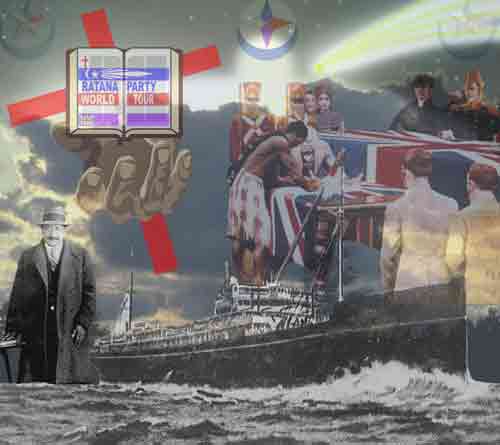
Pita Moko personal secretary to Ratana, had to finalise all details describing their intention for the tour. Ratana was to sail from Wellington on April 11th 1924, for Sydney, on route for England for the British Empire Exhibition. There was opposition in some native quarters to proposed visit of Ratana to England and to contributions being made from the North Island Maori specifically for this purpose. Mr Pita Moko had to travel to Wellington to make the arrangements for the trip with the Minister of Native Affairs who was considering the matter to permit Ratana and his party to travel overseas. They were finally requested to deposit with the Government sufficient money for their return passages.
Many questions have been asked as to who is this gentlemen Tahupotiki Wiremu Ratana, and how would he finance his world tour. Most of the questions were forwarded to Ratana’s private secretary Mr Pita Moko who supplied the information to the media. Rumours were speculating saying that Ratana will depart Wellington sometime in April 1924, then from Sydney, Australia, en route for England. Some Maori within the New Zealand Government have been Ratana’s opposition for the past several years. T.W.Ratana had known for a quite some time that rumours of jealousy among his peers both Maori and Pakeha had arisen because of his work in uniting the Maori people turning them away from Tohungaism and uniting them under the one true God. (Truth Saturday 5th April 1924)
When it was known that Ratana would be arriving in England about June, correspondence started to pour into the post office at Ratana Pa and a special room had to be set aside to accommodate the accumulation of letters,
- Preach the Maramatanga (Divine Enlightenment) to the World
- Seek Audience with the King of England regarding the Treaty/Titiri O Waitangi
- Have the Maori Nation represented at the British Empire Exhibition
While on the his 1924, world tour of the British Empire, the people from different cultures and backgrounds marvelled the work of T.W.Ratana Mangai; Ratana and his party received hospitality everywhere they went, his sincerity, wisdom and the miraculous healings of the sick and infirm were acknowledge by many people from different beliefs, where he was able to preach the Gospel and making the Maori people known to the world (WM; June 1981, pg7; Ratana T, World Tour Journal 1924)
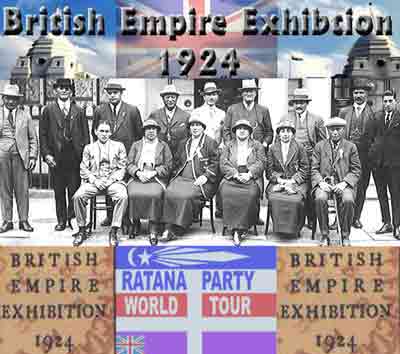
News spread through the International scene explain about Ratana, known to most people as the Miracle Man with his group will travel by the boat Maheno and will arrive in Sydney. Many newspapers were saying that under the leadership this famous Maori Faith healer Ratana and his party while in Sydney, explained he is en-route to the Empire Exhibition. Several years ago Ratana was not know to the public, today, his name and miracles healings are known to every person in New Zealand. With thousands of “Cures” for healing blindness, rheumatism, and paralysis have vanished at the instance of his wonderful gift to heal with the power of “Faith”. Tahupotiki Wiremu Ratana was the most talked about man in New Zealand during the early part of his ministry.
Nga Moutere me nga Paa i takahia e T.W.Ratana me tana Roopu 1924
Australia: Sydney, Hobart, Melbourne, Adelaide, Brisbane, Townsville, Thursday Island
South Africa: Durban, Cape Town
The Equator: 30th May
Canary Island: Las Palmas
England: London, Walthamstow, Liverpool, Dover, Folkstone, Hertford, Leicester, Nottingham, Sheffield, Leeds, Carlisle, Crewe, Stafford, Warwick
Scotland: Edinburgh, Glasgow, Stranraer
Ireland: Belfast, Larne
Belgium: Antwerp, Ostend, Brussells, Liege
Germany: Cologne, Dusseldorf, Essen, Minden, Hanover, Spandan, Be
France: Boulogne, Amiens, Paris, Dijon, Bourge, Lyons, Valence, Avignon, Marseilles
Switzerland: Belgrade, Genva
Sicily: Messine
Egypt: Port Said
The Red Sea:
Ceylon: Colombo
Malay Peninsula: Singapore
China: Hongkong, Shanghai
Japan: Kobe, Osaka, Kyoto, Nagoya, Yokohama, Tokyo, Kasiwaki, Shinonomachi, Nagasaki
Phillipine: Islands Manila, Zamboanga
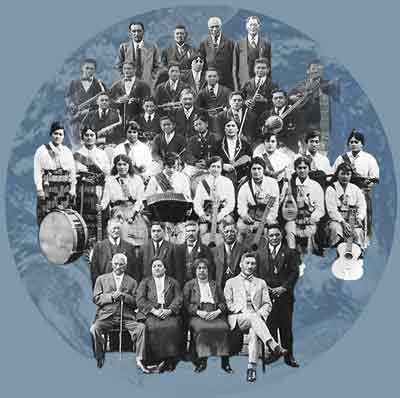
Ratana’s Trip to the Empire Exhibition
1924
Pita Moko personal secretary to Ratana, had to finalise all details describing
their intention for the tour. Ratana was to sail from Wellington on April
11th 1924, for Sydney, on route for England for the British Empire Exhibition.
There was opposition in some native quarters to proposed visit of Ratana
to England and to contributions being made from the North Island Maori
specifically for this purpose. Mr Pita Moko had to travel to Wellington
to make the arrangements for the trip with the Minister of Native Affairs
who was considering the matter to permit Ratana and his party to travel
overseas. They were finally requested to deposit with the Government sufficient
money for their return passages. When it was known that Ratana would be
arriving in England about June, correspondence started to pour into the
post office at Ratana Pa and a special room had to be set aside to accommodate
the accumulation of letters.
(World Tour Journal 1924; Hagger A.R, Sacred Icons Ratana Movement and Church 2003)
On the 1924-25, world tour were Mr Morehu Phillips (Ngati Whatua), Mr Henare Paikea Toka (Ngati Whatua), Mr Eruera Pairama (Ngati Whatua/Nga Puhi) and Mr Timi Hahiwutu (Te Aupouri/Te Rarawa), plus one young lady Miss Huhana Sue Toka (Ngati Whatua) represented Te Taitokerau. The late Tumuaki Te Reo Hura was the last member of this 1924-25 world tour party to pass away in 1991.
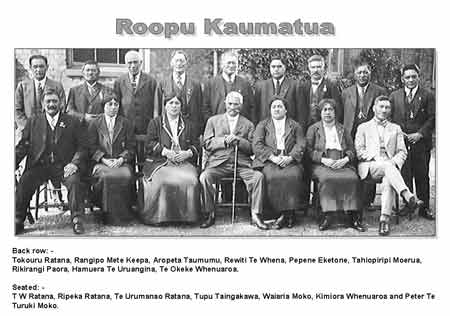
Nga Apiha Whakahaere O Te Tiima O Te Mangai
Perehitini Aropeta Tamumu
Taraketi ki te Uniana O Ingarangi, Pepene
Eketone
Hekeretari ko C. Whenuaroa
Kai Tiaki Moni Uru Te Angina
Kapene T.W.Ratana
Ko Te Tiima Poi ano hoki Tenei A Te Mangai
I Runga Nei Ko enei nga kaumatua whaka-haere o nga Tamariki Wahine.
Urumanaao T.W.Ratana
Waiaria P.Moko
Ripeka H.T.Ratana
Kimiora H.whenuaora
Morehu Perepe Karanete Ko enei tamariki taane me nga mea wahine ne poi,
he waiata he whakatangitangi he haka hoki a ratou mahi. (WM Te Tai I, 1924: pp1-5)
Tiima koitiri Whakatangitangi a Te Mangai
Maata Ratana Kuita
Piki Ratana Mana toriini
Kara Te Utupoto Panatio
Iriaka Te Rio Piana
Mariana Te Hekenui Mana toriini
Pora Pehimana Kuita
Te Akau Tamumu Whira
Te Huatahi Hue Mana toriina
Huihana Toka Whira
Merekuru Te kahu Taramu nui
Te Aorangi Eketone Tiira kuita
Mihiterina Te Aweawe Tiira kuita
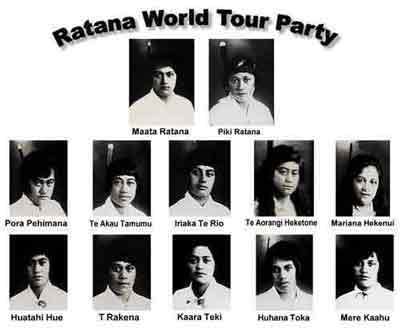
Tiima Haka Whakatangitangi a nga Tamariki
Taana a Te Mangai
Arepa Ratana Taramu nui
Omeka Ratana Taramu Iti
Tariuna Te Aweawe Hekapounu
Huia Whenuaroa Hekapounu
Miki Whenuaroa Taramupounu
Whiu Whiu Pineaha Konete
Paikea Toka Whira
Eruera Pairama Whira
Peina Tamumu Konete
Timi Hahiwutu Karanete
Tani Reremoana Taramu Iti
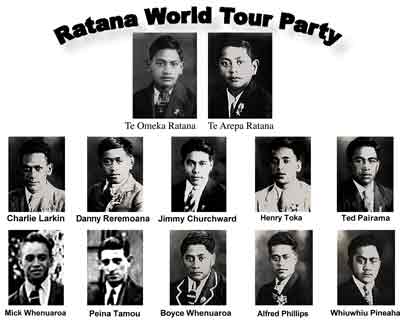
World Tour Party
Tahupotiki Wiremu Ratana had announced he would take a group of 24 young musicians that would perform haka, and poi dancers that will take British Empire Exhibition by storm. He was accompanied by a group of Kaumatua and Kuia to the British Empire Exhibition. Many questions have been asked as to who is this gentlemen Tahupotiki Wiremu Ratana, and how would he finance his world tour. Most of the questions were forwarded to Ratana’s private secretary Mr Pita Moko who supplied the information to the media. Rumours were speculating saying that Ratana will depart Wellington sometime in April 1924, then from Sydney, Australia, en route for England. Some Maori within the New Zealand Government have been Ratana’s opposition for the past several years. T.W.Ratana had known for a quite some time that rumours of jealousy among his peers both Maori and Pakeha had arisen because of his work in uniting the Maori people turning them away from Tohungaism and uniting them under the one true God, which no man Maori or Pakeha has been able to do. (Truth Saturday 5th April 1924)
T.W.Ratana First Destination Sydney, Australia
News spread through the International scene explain about Ratana, known
to most people as the Miracle Man with his group will travel by the boat
Maheno and will arrive in Sydney. Many newspapers were saying that under
the leadership this famous Maori Faith healer Ratana and his party while
in Sydney, explained he is en-route to the Empire Exhibition. Several
years ago Ratana was not know to the public, today, his name and miracles
healings are known to every person in New Zealand. Although, with thousands of “Cures”
for healing blindness, rheumatism, and paralysis have vanished at the
instance of his wonderful gift to heal with the power of “Faith”.
Tahupotiki Wiremu Ratana was the most talked about man in New Zealand
during the early part of his ministry.
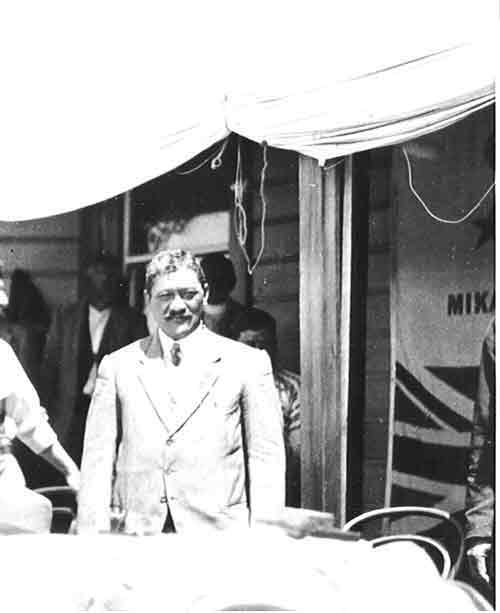
As the Maheno Steamer approached the Sydney wharf, people waiting to see Ratana, could hear music coming from the stern deck of the Maheno to announce the arrival of the “Miracle Man.” This was the Peene o te Mangai (Band of the Mangai) Ratana’s orchestra, of brass, wind, and string instruments which had been playing as the ship entered the harbour. When the ship docked the passengers and visitors were entertained by the Orchestra. Peter Moko Ratana’s private secretary stated that the tour party were paying their own expenses to England. (WM Te Tai, 1924: pg9)

While in England they would be giving concerts and exhibitions while in the British Empire, and all proceeds of which are expected to cover expenses. No concerts will be given in Australia, as the party leaves by the Barrabool. Ratana’s Orchestra, of brass, wind, and string instruments consists of twelve girls and twelve boys. This group will performed some hakas and poi dance exhibitions. The Skipper of the Maheno Captain W.P. Collins was presented with a Maori Chief’s Regalia and custom for his generosity he had show to Ratana and his tour party. (Henderson J, 1963: pg57)
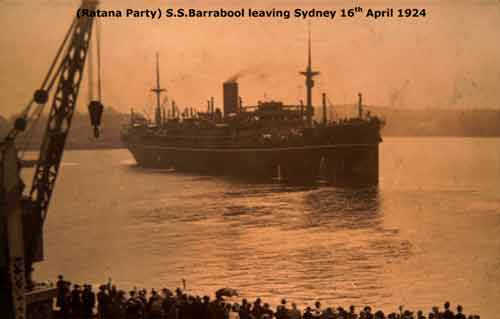
Ratana Girls
The girls Poi and Dance group each wore a dancing kilt (Piupiu) over their
costumes, and danced to the accompaniment of music provided by violin,
a Hawaiian instrument, and a concertina. Part of their performance the
girls were also tastefully dressed in uniform costumes, a blue sports
coat and blue skirt with a speckled straw hat.
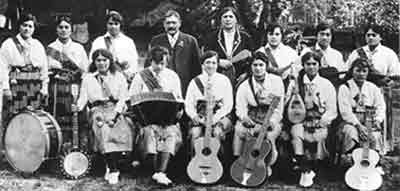
Ratana Boys
The men wore uniform to the extent of wearing straw hats with red and
black colours with the Fern Leaf, and the letters “NZ” in
front. The young orchestra had also formed a very creditable jazz band
of which drums, flute, banjos, and the soulful sound of the saxophones
are the chief components. This orchestra of musicians and poi dancers
will doubtlessly attract much attention abroad while playing their concerts. (World Tour Journal 1924)
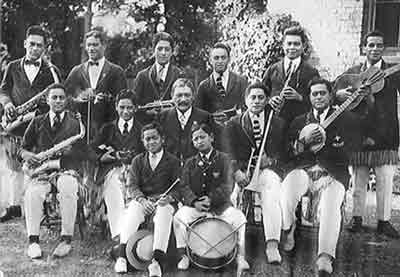
Ratana and his party would sail to London on the P&O Line S.S.Barabool via Capetown, where T.W.Ratana would give a feast to the coloured dockworkers on the wharf. (Editor WM Te Tai: 1924)
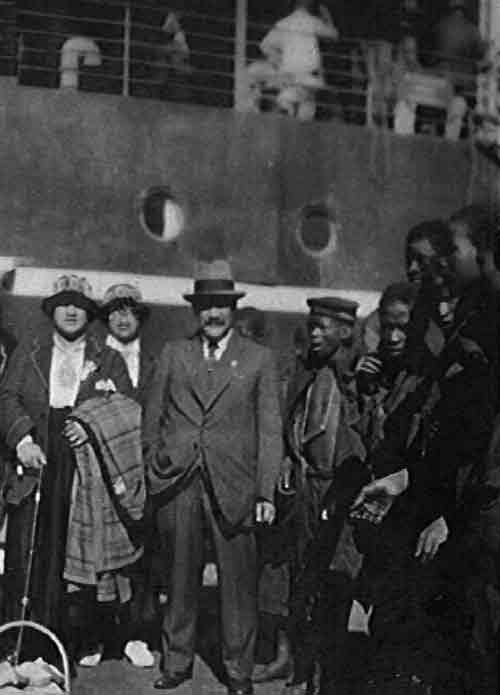
(Extracts from a letter from Ratana’s Son Tokouru Ratana)
“A party of forty Maori who are to take part in tableaux at the Empire Exhibition, arrived on the Liner Barrabool. The voyage from Durban was marked by unpleasantness, Rhodesian passengers raising the colour question. The tension became acute till Australians and New Zealanders sympathising with the Maori threaten to throw the Rhodesians overboard. After that, there was less trouble. The Maori had a section of the ship to them selves and did their own cooking.”
“The disturbance on the steamer Barabool between Ratana’s party and the Rhodesians. The origin of the trouble (states the writer) was at Durban, where Ratana in a sympathetic mood, did not as if the way the Kaffirs (black people) on the wharf were treated, and he ordered a spread with plenty of food (kai) for the Karrirs. This caused irritation among the passengers who joined the boat at Durban and the friction developed on the run home.”
“The Ratana party were very popular with a section of the passenger and were giving their services ungrudgingly entertaining and incidentally winning all the prizes. This created jealousy with a section of the passengers. When Ratana heard this, he withdrew his party from all entertainment. A petition was signed and presented to Ratana asking him to reconsider this matter. Ratana was in no hurry about giving a decision and it was two weeks before the company consented to again appear at entertainment on the boat.” (Ratana T World Tour Journal 1924)
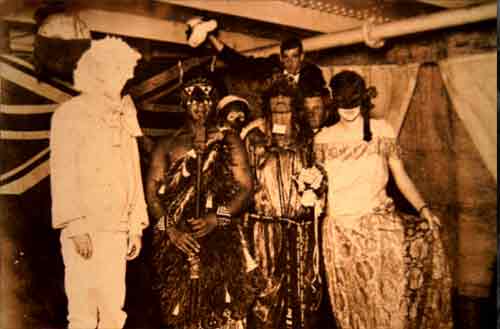
The party were housed at the R.S.A hall in Hoe Street, Walthamstow, and in a hotel by Hyde Park while in England. Private secretary for Ratana, Peter Moko wrote stating that the strain of the work was great; he and Ratana simply flopped down on their seats for sleep in the early hours of the morning after dealing with bags full of correspondence from all over the globe. A great proportion of the correspondence was soliciting spiritual help, and the remainder was about politics, invitation to parties, etc. Ratana had no idea when he would be able to cope with inundation of correspondence or answer numerous invitations. (Editor WM Te Tai: 1924; Henderson J, 1963: pg57)
(June 1924) Ratana in England Thursday
“Ratana Tour Party struck London at lean times judging by the attendance of two of their concerts. Whether it was the poor state of the people or whether they wanted something for nothing, Ratana was not prepared to say. He subsequently hired the King George Hall and gave a free show, when the attendance could not cope with rush for seats.” A cablegram has since been received from Ratana stating that he was to arrive in Edinburgh last Tuesday, and would reach Belfast today. Ratana has received six American letters, three German, one Russian and an Australian, all asking for spiritual help in one form or another. Two of the American writers saw advertised in American papers about the work of Ratana. One of these wrote to Ratana before and this time she wrote back thanking him for spiritual help received. Another writer explained how he got rid of various vices, but to give up his favourite pipe appeared to be the hardest task of all so toward the end he solicited Ratana’s help”. (Telegraph Correspondent June 1924)
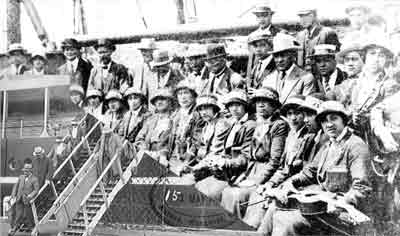
(22nd May 1924) Empire Exhibition
Maori House visited, whole pavilion inspected, Received May 21st 10.30pm
London, May 21st
“The Royal Party went to the Maori House outside the New Zealand
Pavilion; Major Dansey explained the house carvings. The King remarked
“I have a great admiration for the Maori; they are a most courageous
race. The whole party was photographed outside the house. They then
entered the magnificent rimu-panelled reception room of the New Zealand
Pavilion where they signed the visitor’s book and the Queen was
presented with a New Zealand rug. The party toured the pavilion where
the Queen momentarily sampling the temperature of the refrigerated chamber
where there were fourteen degrees of frost. The Queen next, minutely
examined needlework by New Zealand school children. Passing to the Samoan
Hut the Queen was presented with a Samoan mat. There His Majesty expressed
his intention of making a closer inspection of the pavilion later.” (By
Telegraph June 1924)
Ratana at Wembley Maori Disappointed, Native
House
(By Telegraph-Own Correspondent (Wanganui Sunday 1924)
“Interviews regarding the visit of Ratana and his party to England
and the Continent, private secretary of Ratana, Mr Moko, was asked how
the party had been treated generally in England. Mr Moko replied that
they had been treated in a very off-hand manner. He went on to state that
all sorts of coloured races were represented at Wembley. Even to Zulu’s,
who had their fares paid. When Ratana’s party visited Wembley they
paid their own expenses. At the request of Sir James Allen they gave an
entertainment there, and had tickets issued to them, but kept these and
paid their own expenses. Speaking of the Maori House at Wembley, Mr Moko
said it was a disgrace. It was a Maori House represented to the late Queen
Victoria, and had been stowed away for nearly fifty years. The carving
was excellent, but the panelling was an eyesore, and all European. As
for the mats, he would not have them on his own doorstep. He maintained
that if the authorities intended to have the Maori’s represented
they should have made a display that was creditable to the race. We were
the only coloured race under the British Flag that did not have proper
representation at the exhibition. The coldness shown was strange, seeing
that the Maori boys had proved themselves as such good fellows during
the Wartime at home and were respected.
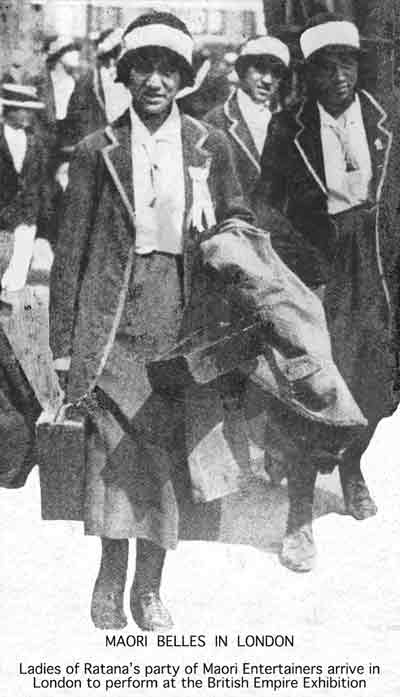
Telegraph Received May 21st 10.30pm London, May 21st “The Royal Party went to the Maori House outside the New Zealand Pavilion; Major Dansey explained the house carvings. The King remarked “I have a great admiration for the Maori; they are a most courageous race.” “The party was photographed outside the house. then entered the magnificent rimu-panelled reception room of the New Zealand Pavilion where they signed the visitor’s book and the Queen was presented with a New Zealand rug. The party toured the pavilion where the Queen momentarily sampling the temperature of the refrigerated chamber. The Queen examined needlework by New Zealand school children then passing to the Samoan Hut the Queen was presented with a Samoan mat.
Ratana at Wembley Native House Telegraph-Own Correspondent (Wanganui Sunday 1924) “Interviews regarding the visit of Ratana and his party to England and the Continent, private secretary of Ratana, Mr Moko, was asked how the party had been treated generally in England. Mr Moko replied that they had been treated in a very off-hand manner. He went on to state that all sorts of coloured races were represented at Wembley. Even to Zulu’s, who had their fares paid. When Ratana’s party visited Wembley they paid their own expenses. At the request of Sir James Allen they gave an entertainment there, and had tickets issued to them, but kept these and paid their own expenses.”
Speaking of the Maori House at Wembley, Mr Moko said it was a disgrace. It was a Maori House represented to the late Queen Victoria, and had been stowed away for nearly fifty years. The carving was excellent, but the panelling was an eyesore, and all European. As for the mats, he would not have them on his own doorstep. He maintained that if the authorities intended to have the Maori’s represented they should have made a display that was creditable to the race. We were the only coloured race under the British Flag that did not have proper representation at the exhibition. The coldness shown was strange, seeing that the Maori boys had proved themselves as such good fellows during the Wartime at home and were respected.
At the Hampstead Conservatoire the Ratana concert party gave a Maori entertainment unique in London in aid of the League of Mercy Fund, for the support of hospitals. All members of the party were dressed in native costume, and their program was greatly enjoyed. A poi dance was received with delight. Prior to the musical program, Peter Moko, private secretary of Ratana, explained the objects of the presence of his party in England. They were here, he said, firstly to disseminate the Power and Glory of God, and secondly to place before the Imperial Government their grievances. Almost from the first the Treaty of Waitangi was not venerated, as years went on it became increasingly apparent that it was not being fulfilled.
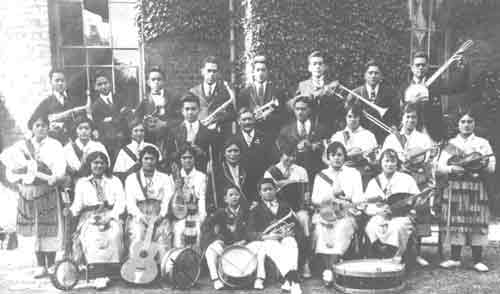
The Maori party had come to England as representatives of their race, to entreat England to rectify the injustice. He had hoped when they arrived in this country to receive recognition from the Christian element, but he regretted this was not so. Nevertheless, they had had a very sad visit. The party intended to do a very extensive tour, including Scotland, Ireland, Belgium, France, Switzerland, Italy, Egypt, India, Ceylon, Japan, and the Pacific.” Ratana in England, no recognition by Churches, 19th September 1924.

An invitation given to the three representatives of the Ratana 1924 World Tour Party. Tupu Taingakawa Te Waharoa, Rewiti Te Whena and Hami Tokouru Ratana Chiefs of Maori Tribes of New Zealand who are on a mission to the Government of England are present before the Royal Highness the Prince of Wales. (By Telegraph Correspondent June 1924)
Interview Prince of Wales 1924
Tahu Pakeha: H.R.H The Prince of Wales
1924
Greetings to thee, o Prince of Wales.
Greetings to thee, the eldest born of his most Excellent Majesty King
George the Fifth and of her most Gracious Majesty the Queen.
“Greetings to thee, the Grand Child of your Grand Elder who never waived their Aroha to the Maori people, who dwells within the precincts of Aotearoa, Waipounamu, and Whare Kauri. Whom king William the Forth in 1835, presented with a National Flag as a token of Arohanoa, further more to confirm to the tribes the declaration of independence and Chieftainships in unity. Your Gracious Great Grand Mother the Late Queen Victoria endorsed this, by empowering the Treaty of Waitangi to be signed in the year 1840. Therefore Greetings to the Prince of Wales.
Greetings to thee as President of the League of Mercy. I am very grateful for the honour of meeting you your Royal Highness today. Your memorable speech of 1920, at Rotorua N.Z recalls to mind your Royal Highness expressed wish to meet again at a future date. Today Sir I thank you, for it has been fulfilled. Therefore, we Tupu Taingakawa Te Waharoa, Rewiti Te Whena and Hami Tokouru Ratana Chiefs of Maori Tribes of New Zealand who are on a mission to the Government of England and are present before you today feel grateful for the Honour of meeting you your Royal Highness. May God Bless you and may you have long life and prosperity. May the blessing of the Lord be endowed upon His Royal Majesty King George the Fifth and upon Her Gracious Majesty the Queen and the whole of the Royal Family.”
“Ka mutu taku panui tenei mihi kua oti ake nei, pahi tia ana ete Mangai menga Morehu katoa. Heoi ano ka mutu mo tenei ra.” (World Tour Journal Ratana T, 1924: pp23-24)
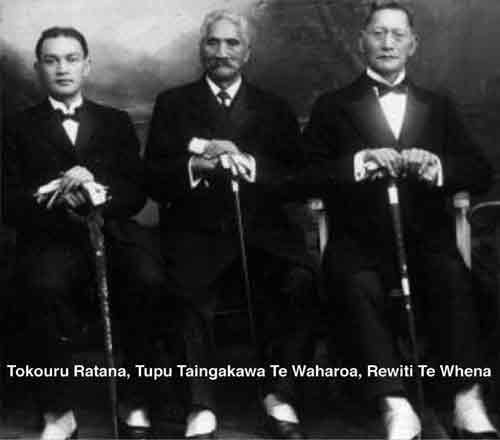
|
Original Passport
Full World Tour Band
Letters Asking for Healing
Steamship Barrabool
|
Ratana in England
Ratana and his touring party were very striking to demonstrate the dignity and independence of the Maori people. From passing to the New Zealand pavilion and back to the station, photographers and interviewers were eager to know something about Mr Ratana and his party even to the extent of taking photographs of them. They evaded publicity of any kind however, with refusal even in the privacy of the New Zealand grounds cameramen were warned not to attempt to snap them. Ratana and his party keep almost entirely to themselves and information that might possibly be used for publication was strictly forbidden. Mr Moko, private secretary of Ratana dealt with all enquiries from pressmen, and gave them nothing more than what is absolutely necessary. Mr Eketone, and Ratana’s wife and her two daughters Piki and Reo, and Mr Moko, and another member of the party were presented to Princess Helena Victoria. The Princess was the recipient of a New Zealand travelling rug given by the wife of T.W.Ratana, Urumanao. Eketone presented to lady Allen a Piupiu (kilt), which they desired should be shown in the Maori House until the end of the Exhibition”. (Ratana T, 1924 World Tour Journal)
T.W.Ratana Mangai stood on the Westminster Bridge in London with his Band and spoke these words. When all your castles (stone houses) are destroyed in time to come, then will the carpenters, the blacksmiths and the shoemakers be in power, and I will be the Government.” T.W.Ratana Mangai foresaw the coming of the Luftwaffe to London during the 2nd World War, and the election of the Labour Government in Britian and New Zealand. Ratana Piri Wiri Tua would eventually selected four members and join forces with the Labour Party. Ratana's party were housed at the R.S.A hall in Hoe Street, Walthamstow, and in a hotel by Hyde Park while in England (Henderson J, pp57-58; 1963) |
Ratana and his Party were welcome guests and were honoured during their stay in the Japanese community. The greatest love sown in Japan in 1924, had been the unity of the Japanese people and the Maori people. This man Bishop Juji Nakada opened his doors of his great house to T.W.Ratana and his Party. As Juji Nakada insisted, he had known that, a great and most honoured guest had arrived on this day in Japan.
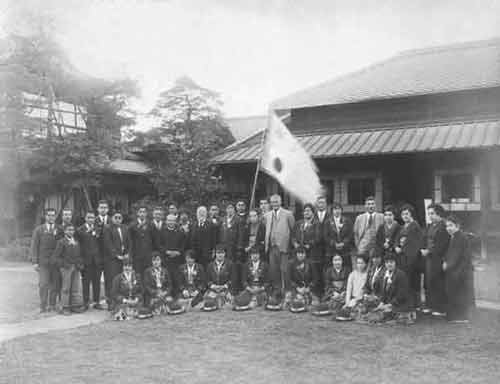
A grand reception was arranged and a service was conducted with hymns and prayers spoken in the Maori Language. On this occasion there was also a marriage, Ratana’s daughter Martha married Huia Whenuaroa, the ceremony conducted by Bishop Juji Nakada, Seisha Gakuin, and Yodobash in Japan on the 8th November 1924, with a cake made in three ornate tiers by a member of Bishop Nakata’s family. On Ratana’s departure from Japan, he was presented with a traditional Samurai sword from Count Mishenti.
(Henderson J, pg59; 1963, Akoranga, Anaru; pp59-60: 1997)
Ratana explained that the Maori and the Japanese people belong to the lost tribe of Israel, they had been misunderstood, and that a chain of ancestry linked both people, and their customs being very similar concerning their greetings and hospitality. Some Maori words have the same meaning as the Japanese words as explained by Ratana’s private secretary Peter Moko that they originally set out from Palestine, travelled through Persia and India, and down to the Malaya Peninsula where the tribes drifted apart with the Maori people migrating South down to Aotearoa. (Otago Witness January 20th 1925)
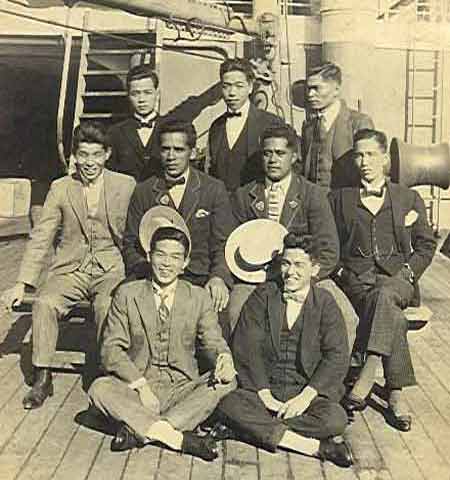
However, the bond between the Maori and Japanese people would eventuate in 1927-28, in detail for the Bishop Nakada’s crusade to New Zealand. The bond between the Maori people and the Japanese people had been established, but this would become the talking issue of controversy to the New Zealand Government in later years, due to the Second World War and Japans relationship with the T.W.Ratana and the Ratana Established Church of New Zealand.
The Japanese youth (Kito) who came back with Mr Ratana on his return trip from Japan was a student at Bishop Nakata's school for Ministers. Bishop Juji Nakata wrote to Ratana sending a letter of greetings on the 27th October 1927. In his letter, he began with scripture taken from the Bible that would herald the coming of his trip to New Zealand, he made known his platform would be hope, faith and love, as said by the Apostle Paul, “the greatest of these is love.” (WM Paikea, 197: 1928)
“He Rongo Pai No Te Whenua Tawhiti, Tona Rite Ki Te Wai Matao Ki Te Wairua Matewai.”
"Goods News from a far off land is like cold water to a thirsty soul.” (Proverbs 25:25)
Departure from Japan “Information has been received that Ratana and his concert party, who have been touring the Homeland and Japan, intend to be back at Ratana for Christmas. Great preparations for Christmas festival are being made. This will probably be the largest native gathering held in the Dominion for many years.”
“Ratana Pa has developed into quite a large village and the social life of the Maori people is being particular well catered for. With its own newspaper, and its bank, the Ratana Movement is assuming large proportions and the organization is becoming stronger and more Europeanised as the months roll by.” “The power behind the throne of Ratana is Peter Moko, private secretary of Ratana, and it is mainly due to his organising ability that this native village near Turakina is playing such an important part in the lives of the Maori people. Invitations have been issued for the great gathering on Christmas day to a very large number of natives, and already the trains are bringing many families in readiness for the meeting. Ratana and his tourist party left Japan for Thursday Island recently, and it is expected that they will reach home on 22nd December 1924.” (Ratana T, World Tour Journal 1924)
1925 AMERICAN TOUR
On the 19th August 1925, T.W.Ratana and his Roopu let New Zealand to travel to the South Pacific through Asia and America. While in America they visited the American Trade industry the Wheat industry, building networks and meeting the Trade Council including the American Express Company. They travelled to San Francisco staying at a private house given for the duration of their tour. On this tour Tahupotiki Wiremu Ratana took a party of 27 woman and men this time concentrating mainly on the American continent, the party was away four months and seven days. The touring party visited Canada, Vancouvor, Mexico and visiting the Mormon Tabernacle where a spiritual marriage had taken place. T.W.Ratana Mangai spoke these words concerning the first Piri Wiri Tua the child buried in America. (Editor WM Te Tai, No.78: 1925; Editor WM Te Tai, No.41: 1925)
“Stay for a time, shall give you to rise, Rise then, Rise together with the Nations of America. For I shall fetch you near, and observe and raise you up.”
T.W.Ratana Mangai then secured a Guardian upon the grave of the child.
“Oh Morehu, you know not the reason of my way (trip to America) for I shall say to you all, there I shall acquire the Olive Branch O (Live).”
T.W.Ratana Mangai spoke about the gifts taken to America in relation to the Moving Pictures of the life in Ratana Pa portraying life in the sanctuary of Ratana.
“For these have been place there for a time, they shall reveal Prosperity and fruits from these gifts.”
In America Ratana travelled amongst well-known business, people the likes of Henry Ford, to elaborating to matters of “Patents” that had been placed with the best of the industry. Ratana was offered an American express cheque for 150,000 pounds to which he refused. Ratana travelled through many cities through America to Canada and to Mexico.
(Te Rongo Pai Hou A T.W.Ratana Mangai: 1940) (Te Tai WM: 1925)
Sanfrancisco, Polo Alto, Oakland, Sacramento, Great Salt Lake City, Ogden, Cheyenne, Buffalo, Albany, New York, Philadelphia, Harrisburg, Pittsburgh, Columbus, Indianapolis, St. Louis, Kansas City, Topeka, Elpaso, Yuma, Los Angeles, Santa Cruz & Santa Jose, Windsor
(Te Rongo Pai Hou A T.W.Ratana Mangai: 1940) (Te Tai WM, No.13: 25th May 1924)
Ratana Invisible Maori Faith Healer Works Cures it was stated by one American paper that the famous praying tribesman from New Zealand, with 26 followers, camped in San Francisco; that he accepts no money and has received 287,000 letters from the sick and the infirm for divine healing. An interesting symptom of our times is the faith cures. It is useless to deny they happen, for hundreds of cases have been investigated and found true, with many faith cures being mentioned in the Holy Bible that have happened throughout the ages. San Francisco is a fair example of a modern city, and for the past two years, her citizens have listened to Coue and admired the cures he brought about by autosuggestion.
They heard Edward Vander Naillen, engineer and mining man, who for sook most of his business interests to preach the Miracle Man in Mexico. Vander Naillen, after being cured, of Cancer, according to his claim, has personally performed over forty years. During these two years, San Francisco read about the followers of the Emmanuel Movement of the Episcopal Church, claiming wonderful recovery of health through the agency of prayer. They heard numerous Christian Scientists give thanks for divine healing at their testimonial meetings. (Editor WM, pp6-7: October 1966)
Now comes the last, or rather the latest, in faith cures that San Francisco is witnessing. The man responsible for them is Tahupotiki Wiremu Ratana, called by his friends, “The Divine Healer” he hails from Ratana, in New Zealand, and belong to an ancient Maori Tribe, of which he is hereditary chief. Ratana is a Christian, say his followers, and achieves his cures by praying earnestly to God. His Secretary, Pita Moko, brought to the office an album of clippings from Australia and New Zealand papers dealing with the marvelous healing powers of his chief, and a number of letters from men and woman giving praise for the regaining of their health. Out of these letters were two local ones. Almost without exception, the cures were made by correspondence. I have not talked to Ratana. His secretary assured me that Ratana could not be seen. Friends of mine who went to consult him were told that Ratana does not show himself to anyone outside of members of his tribe. Yet he travels all over the world, and has just come to San Francisco, from a leisurely tour of European countries, with almost a year sojourn in England. It is announced that in a few days he is setting out for the East together with his secretary, while the 26 tribesmen stay here at Arden wood where they were given hospitality by Mr and Mrs Hawkins. My information therefore, is derived entirely from Mr Pita Moko and the clippings he showed me. (Editor WM October 1966: pg7)
“The staff photograph was not sent, for I was assured that Ratana would not pose for him, as he does not believe in American publicity. Yet, it is understood that a moving picture film will be prepared soon featuring different phases of the healer’s life and activities. This makes Ratana’s positive refusal to appear before a San Francisco camera rather mysterious. Secretary Pita Moko gave assurance that his chief had refused an offer of 1,000 English pounds offered by a New Zealand newspaper syndicate for permission to publish his picture. It follows that, as far as San Francisco is concerned, Ratana may well be non-existent. Alternatively, he may be still in England or New Zealand. There is no way of finding out. Then why mention him at all? Why write about him? Some skeptic will ask, well because if one likes it or not, the fact remains that there are many people in San Francisco and a great many more around the world who happen to be interested in Ratana, who believe that his prayers perform miracles and, what is more, who have become members of his church.” (Editor WM, October 1966: pp7-8; Te Rongo Pai Hou A T.W.Ratana Mangai: 1930-40)
Yes, Ratana has found his church. He calls it the “Ratana Established Church New Zealand”, based fundamentally on the Holy Trinity and their Faithful Angels. I was assured it is a Christian Church, of which the Maori healer is the titular head. Forty thousand of his tribesmen have joined it. What is more, his secretary Pita Moko estimates that members scattered all over the would number to Five Million. England, Germany, Denmark, Spain, Russia, Poland, India, the Philippine Islands, together with Australia, New Zealand and the United States, are all represented.
Ratana, it was said, is a man in his fifties; he first discovered his powers in November 1918. It happened that his son, a boy of twelve had his knee punctured by a needle. Blood poisoning set in and the English doctor gave up all hope. The disgraced father knelt by the bed of the sick lad and prayed. The boy became immediately better, and was well within two days. (WM, October 1966: PP6-8)
They travelled to San Francisco staying at a private house given for the duration of their tour. They visited Canada, Vancouvor, Mexico and visiting the Mormon Tabernacle where a spiritual marriage took place between the Ratana Movement and Mormon Church. T.W.Ratana Mangai spoke these words concerning the first Piri Wiri Tua the child buried in America. (WM, No.78: 1925)
Under construction to be continued...
